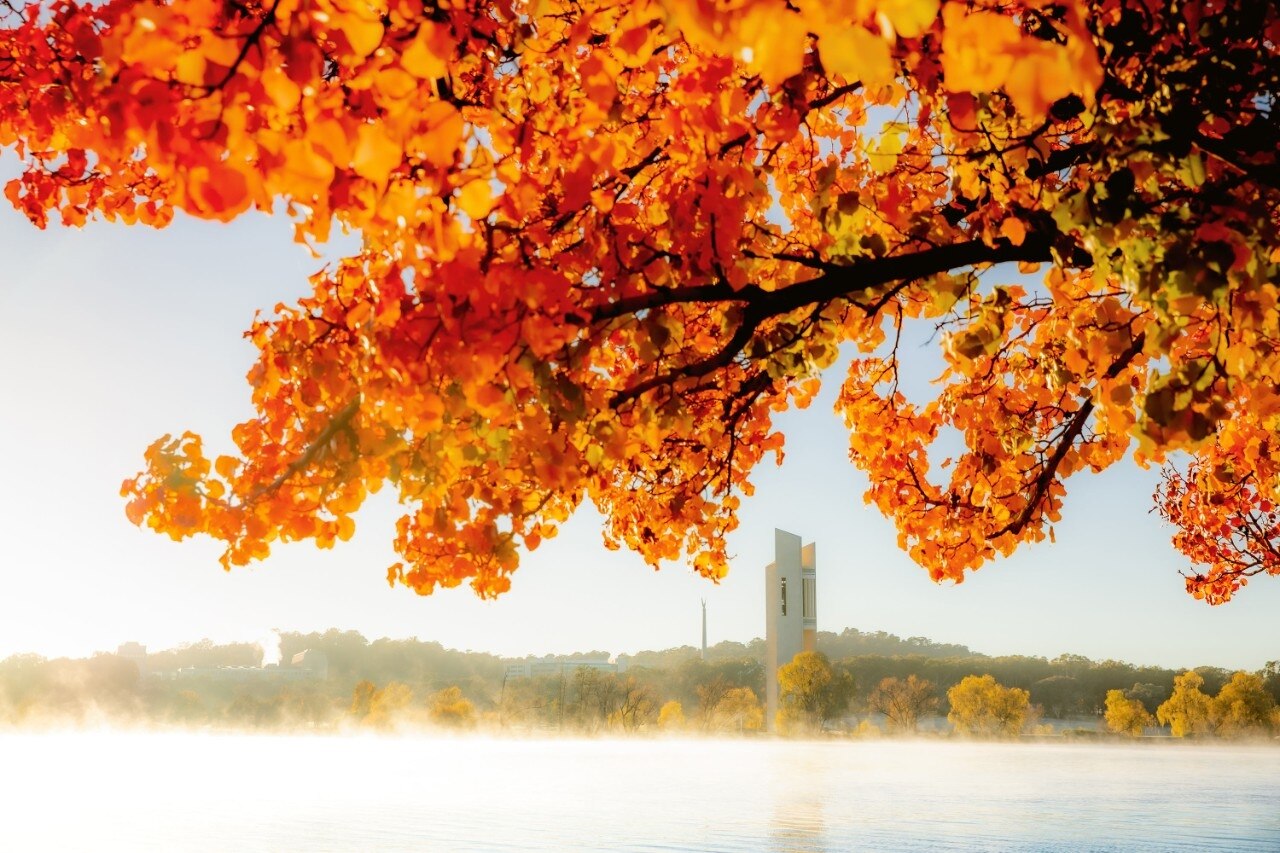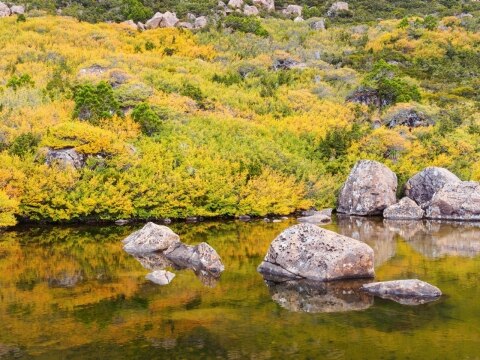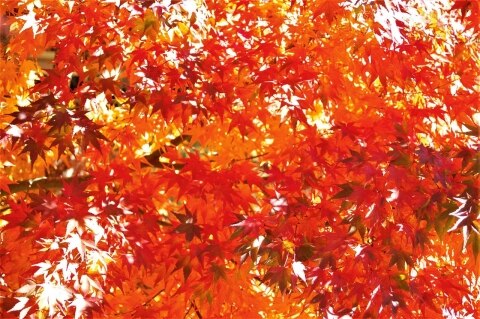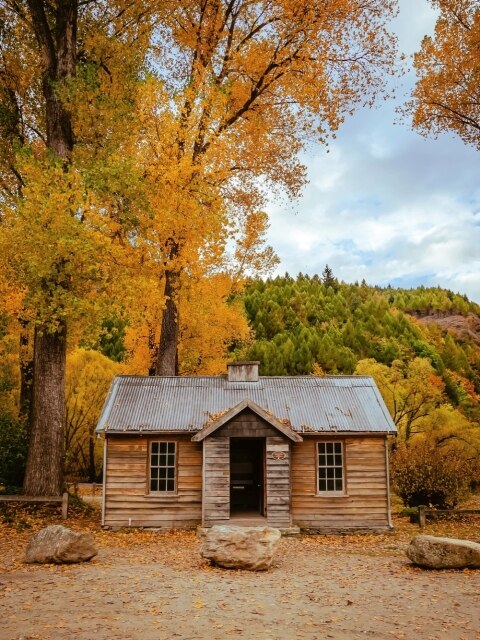7 Incredible Places in Australia and New Zealand to See Autumn Colours

A confluence of cold nights and short days makes autumn-leaves season in Australia and New Zealand a spectacular experience.
All it takes is a single leaf blushing amid the greenery to kindle autumn’s spectacle. The colour spreads swiftly across the canopies lining village streets, crowding parks and private gardens, fringing lakes and collaring mountain ranges. The mostly Northern-Hemisphere specimens – maples, poplars, birch, cherry trees, willows, elms and oaks – appear to have been dipped in pigment: burnt honey, copper, cochineal and scarlet. In truth, these colours already exist within the leaves but few regions experience the dramatic climatic variation necessary to transform their greenery.
“In a climate that has a sharply defined autumn and a cold winter, deciduous trees get the seasonal cue to withdraw chlorophyll from their leaves to expose the underlying anthocyanins, which are responsible for the vibrant autumn colours,” says Daylesford-based professional gardener and botanical tour guide Simon Rickard.
“So, in fact, those colours are around all year, it’s just that they’re masked by the green chlorophyll pigment and when the plant withdraws that, the colours become obvious.”
After a month or so, the display subsides; the leaves crisp, dislodge from their stems and float earthwards, leaving the skeletal trees to shiver through winter.
The best places to observe this ephemeral event, says Rickard, are cool-climate regions with a “preponderance of deciduous trees from the Northern Hemisphere in parks, streets and gardens. And don’t forget, timing is everything. The best month to see autumn colour is April, typically with a peak around Anzac Day.”
SEE ALSO: 100 Australian Bucket-List Travel Experiences
Canberra, ACT
Australia’s capital is known for fiery personalities and debates (and in springtime, the pacifying bloom of tulips showcased during Floriade). Less well-known is its autumnal outburst, when the city’s formal green spaces are a riot of colour-saturated foliage. The leaves are a foil to the officialdom of the Parliamentary Triangle; they flash ruby and gold against a clear sapphire sky and are mirrored in metallic streaks across Lake Burley Griffin.
The weeks either side of Anzac Day offer some of the finest leaf-admiring opportunities, though precise timing depends (much like election dates) on prevailing conditions. The pageant can be enjoyed from a multitude of locations, listed in the city’s interactive autumn leaves map.
Stroll along the lake foreshore; visit the National Gallery of Australia’s Sculpture Garden; picnic in Commonwealth Park; immerse yourself in the deciduous plantations at the National Arboretum Canberra; and get an aerial perspective from a hot air balloon.
And if you can’t make it to the capital, watch for federal budget day television newscasts, in which the chromatic maple in the Senate courtyard often features – it’s known as the Budget Tree.
Stay
The heritage-listed Hyatt Hotel Canberra sits on formal grounds with views of Lennox Gardens. Repair to the Speaker’s Corner Bar for an aperitif or nightcap and warm chilled fingers at cosy retreat Griffin’s open fire, where the décor is inspired by the property’s Art Deco origins.
Eat and drink
Canberra has plenty of incredible restaurants to choose from. The popular fish-and-chips menu at the revamped Snapper & Co. (due to reopen in October 2021), on the shores of Lake Burley Griffin, will also include charcuterie share plates and gourmet burgers and pizzas; dine in the licensed courtyard or order takeaway and soak up the tree-fringed, colour-washed water views from the lakeside lawns. Chef Pradeep Manupriya’s modern European-Australian fare is one attraction at Onred; another is the autumn-tinted city viewed through the restaurant’s circular glass walls. Stick to the seasonal theme with pan-seared quail breast with maple syrup jus or kangaroo fillet with cognac pickled blackberry jus.
SEE ALSO: Discover the New Surprising Things to do in Canberra
Mount Field National Park, Tasmania

A rare occurrence is foreshadowed on the hour-long drive from the village of New Norfolk to Mount Field National Park, about 80 kilometres north-west of Hobart. Yellowing hops cascade across the landscape, flaxen poplars line farm driveways and the banks of the Derwent River are defined by a haze of sulphurous foliage. But the grand finale awaits: the “turning of the fagus”, when Australia’s only true temperate native deciduous tree, a beech commonly known as fagus, dazzles gold, carnelian and burgundy in the higher reaches of this alpine park.
Experienced walkers are rewarded on the seven-hour round-trip hike to Tarn Shelf with reflections of luminous fagus dancing on the surface of glacial lakes. More accessible is Lake Fenton, the only place where visitors can drive through stands of fagus during the fleeting change. Guided walks are available and a shuttle takes visitors to the site during the annual Fagus Weekend, held on the weekend closest to Anzac Day.
Look out for Tasmanian devils and – if time permits – head to Russell Falls through towering swamp gums to check out one of the most impressive cascades in Tasmania.
Stay
After a day of alpine exploring, retreat to one of Australia’s oldest historic houses, the stately Woodbridge Inn, located by the Derwent River in New Norfolk. Each of the inn’s eight rooms – individually furnished with modern décor that offsets heritage features – has a water view. The dress- circle setting allows for low-key appreciation of the turning seasons: stroll along the river or have tea beneath the property’s autumnal almond trees.
Eat and drink
Grab a seat at the Fagus Weekend Lazy Lunch held at Waterfalls Café & Gallery in the park’s visitor centre. The feast is sourced mostly from within a 30-kilometre radius and includes delicacies such as hop-fed, spit-roasted lamb and fresh raspberries. In New Norfolk, enjoy a seasonal weekend lunch dreamed up by Rodney Dunn and Séverine Demanet at The Agrarian Kitchen Eatery. For an alfresco experience order from the Kiosk and picnic near the glowing old oak tree.
SEE ALSO: 24 of the Most Beautiful Natural Wonders to See in Tasmania
Victoria’s High Country

Early to mid-autumn intensifies the drama of this alpine region, located about three hours drive north-east of Melbourne and dotted with gold-rush-era towns and villages.
Beechworth’s wide streets are a delightful stage-set for century-old trees; mature specimens – many of them listed on the National Trust’s register of significant trees – can be viewed at the town’s Mayday Hills. Go mountain biking or hire an e-bike to cycle the Murray to Mountains Rail Trail and witness a Jackson Pollock-like spatter of crimson, ochre and burnt sienna foliage on the Bright to Wandiligong leg (11 kilometres return). Or take in the whole scene from Beechworth to Myrtleford and Bright on two wheels with the five-day Tour de Grand Gourmet.
Stay
Flaming maples and silver birch light up the road that leads to The Buckland Studios, a couples-only bed and breakfast located in the Buckland Valley, 12 minutes drive from Bright. The property’s five luxurious studios and a spa are tucked away in a peppermint-gum plantation facing Mount Buffalo.
Eat and drink
Admire the crepe myrtle’s honeyed leaves from the deck at Billy Button’s Myrtleford cellar door (operated with Bush Track Wines) or retire to the period-style salon and taste Jo Marsh’s lauded local wines by the open fire. Book a table at Provenance, where chef Michael Ryan features Japanese-inspired, locally sourced cool-weather dishes, such as mushroom tofu with katsuobushi salt and kohlrabi cooked in black tea and vinegar with umeboshi purée. At golden hour, pull up a stool beneath the vines at Bright’s Reed & Co Distillery, where the secret ingredient in Hamish Nugent and Rachel Reed’s Gin & Juice and Mistelle is alpine grape juice from Billy Button.
SEE ALSO: Discover the Beauty of Victoria’s High Country
Central Otago, New Zealand

Autumn sweeps across Central Otago like a tide, gilding everything in its path. Anchored by Queenstown, Roxburgh and Ranfurly in the southern centre of the South Island, this district encompasses some of New Zealand’s most magnificent scenery. Here, the vegetation glows in the two weeks leading up to Anzac Day: valleys fill with golden native tussock grass and newly harvested vineyards blaze copper, brass and amber, all imprinted upon the polished surfaces of glacial lakes.
The Central Otago Touring Route traverses 341 kilometres of countryside between Queenstown and Dunedin on the east coast. At Chantecler Gardens in Queenstown, oaks, liquid ambers, rowans, ashes and redwoods flame against the ice-streaked Remarkables mountain range. Stop for photos at the historic village of Arrowtown, nestled below hills painted in every autumn shade. And wander through the patchwork of orchards and vineyards at Cromwell and visit the famous V-shaped fruit trellises – densely planted and trained to create tunnels of colour – on a tour of Jackson Orchards. You can also glide through the picturebook landscape on one of the region’s many cycling trails – but be warned, bikes and accommodation along these tracks book out fast.
Stay
The boutique Mt Michael Lodge close to Cromwell is abutted by burnished vineyards and inky Lake Dunstan, all framed by the Pisa, Dunstan and Carrick ranges. Watch the sunrise over the water from your lake-view suite and in the evening sip pinot noir from the adjacent vineyard in your private courtyard as another day’s colour fades slowly into night.
Eat and drink
Enjoy a late lunch (hint: order chef Gwen Harvie’s slow-roasted lamb oyster shoulder – a sweet, marbled cut – paired with Magnetic pinot noir) on the terrace of Carrick Winery & Vineyards’ restaurant when the high sun hits Bannockburn Inlet and the Carrick mountain range. Pop into the Bannockburn Hotel’s Wine Country Restaurant & Bar for Gibbston Valley pinot gris and take beautifully lit photographs of Kawarau Gorge, Mount Pisa and the Cromwell Basin. It’s not easy to concentrate on head chef Werner Hecht-Wendt’s offerings at Mt Difficulty Winery restaurant and tasting room, where views of the gold-mine sluicings, terraced vineyards and the glittering Kawarau River are a worthy distraction. Once you’ve refocused on the menu, commit to a hearty dish such as wild mushroom gnocchi paired with Roaring Meg chardonnay.
SEE ALSO: 7 Secret New Ways to Experience New Zealand
Three more places to visit...
Blackwood River Valley in Western Australia
You might not imagine the west would be a symphony of colour in autumn. But in this part of the country, three hours’ drive south of Perth, you’ll discover an undulating, lush landscape and historic towns. Take the scenic route to Nannup, following the valley and you’ll see the deciduous trees along the way turning flame red, yellow and orange. Alternatively, take a picnic basket to the Golden Valley Tree Park near Balingup where there are stands of exotics – oaks, redwood, giant sequoia and elms – from across the world. At this time of year, there’s another interesting change in the flora. Towering native karri trees drop their grey bark to reveal orange and pink hues beneath.
Bowral in the NSW Southern Highlands
The European history of this town, the largest in the Southern Highlands and about 90 minutes from Sydney, stretches back about two centuries, but it was in the late 1800s that its landscape was altered. Sydney’s elite began travelling to Bowral and treating it as a rural retreat. With them they brought deciduous trees to the region to make the area appear more English. One of visitors’ favourite gardens is Moidart, which has acres of mature trees including red oaks, golden elms, plane trees, copper beech and tulip trees, all of which change dramatically during autumn.
Victoria’s Dandenong Ranges
Just an hour from the centre of Melbourne, the villages atop the ranges are surrounded by gardens, each with its own peak time each year. For autumn colours, head to the Alfred Nicholas Memorial Gardens, named after a Victorian merchant and philanthropist and which was once part of the expansive Burnham Beeches estate, built using the profits from Alfred’s brother George’s invention, Aspro. Alfred visited the Chelsea Flower Show in 1929 bringing back many plants and ideas you can still see in the gardens. In autumn, the foliage of the maples and beeches changes, but the most spectacular sight is down by the lake where the golden ginkgos create a postcard view.


